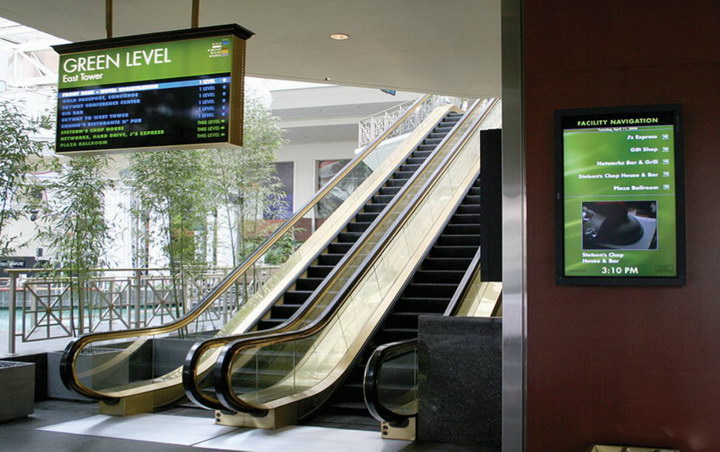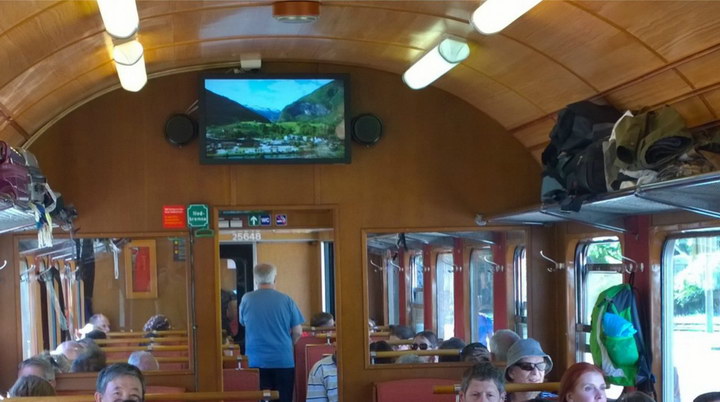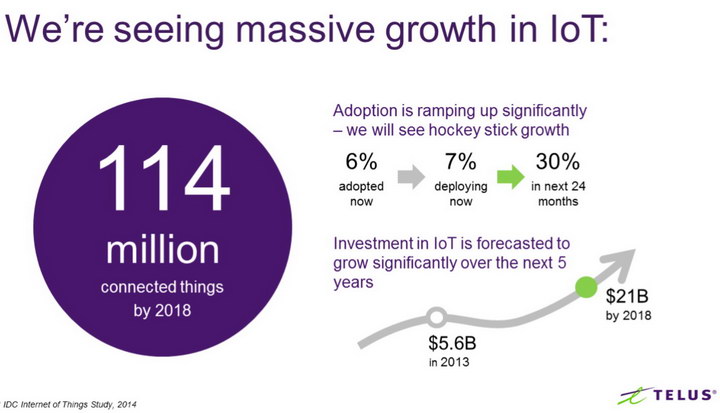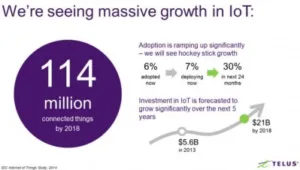The Internet of Things (IoT) comes up most often, perhaps, in terms of consumer systems. For example, thermostats can learn your habits and adjust the schedule for your furnace automatically to maximize comfort and economy. Or a front door lock which allows you to view visitors on your smart phone from anywhere in the world and unlock the door for them.

I recently attended a webinar titled ‘The Internet of Things and Digital Signage – A Smart Combination’. Presenters were Jeff Collard, President of Omnivex (www.omnivex.com), a Canadian software and services provider for digital signage, and Stephen Eyre, Director, IoT Partner Ecosystem, at Telus, a Canadian wireless service provider. Chris Hall from Digital Signage Today (www.digitalsignagetoday.com) was the webinar moderator.
Most people think of digital signage as the presentation of pre-programed images, sometimes static, but increasingly video-based. This view of digital signage is mostly non-interactive. In a store, it could be a series of images of clothing they sell and sales they are running, perhaps interspersed with maps of the store layout. In a hotel, it could be a list of events going on and the rooms they are in. If there are too many events, then there may be two or more images alternating to show them all. In either example, a touchscreen can be used to provide manual access to a broader variety of data and images.

The IoT makes this simple model of digital signage look old fashioned. One of the key elements of the IoT is the use of sensors – the more the better. In the hotel example, for instance, the badges given to attendees of the various events going on can be RFID badges. An event attendee with an RFID badge can walk up to a digital signage display equipped with an RFID reader, the display reads his badge and shows all the meetings associated with that event, including schedules and how to get there. Don’t have your badge yet? A sensor in the sign, perhaps a camera, detects a person is there without a badge and gives directions to all registration booths for the different events going on in the hotel.

Another example of the combination of the IoT and digital signage given by Collard was the Flamsbana train, self-proclaimed to be “the most beautiful train journey in the world”. This train starts at a Norwegian fjord and climbs with an average 5.3% grade to a point 867m above sea level, where it connects with the Oslo – Bergen rail line. As can be imagined, the line attracts tourists from all over the world, speaking a wide variety of languages. This is where the IoT and digital signage comes in.
The IoT starts with sensors to detect the train’s location. Due to the 20 tunnels and the mountainous country, GPS is unreliable, so sensors on the train pick up location markers at the track edge. This triggers images of what you are seeing outside to be shown on the signage monitors in every car. In addition, an audio description is given over the speakers. This audio is capable of handling three languages per car, giving the descriptions in turn in each language. Currently, at the beginning of the trip, the conductor programs which three languages will play in which cars, based on the tickets sold.
While this is a simple IoT system because the signage controller talks to the train location sensor without human intervention, it has two problems. First, it requires the conductor to spend his time entering data into the system, rather than, well, conducting the train. Second, if a passenger moves from one car to another, he may wind up in a car where his language is not being provided. Collard sees more IoT as the solution. Microphones in every car could pick up pick up spoken words in each car, use voice recognition to identify the languages spoken and use the appropriate languages. Normally everyone in a car says something, even if it is just talking to the conductor who collects his ticket. This would relieve the conductor of the job of setting the languages on a per-car basis and could take care of people moving from car to car. Of course, when they go to a new car, they have to say something to somebody for this to work but my experience is that tourists are always saying something. (clearly, US tourists – Man. Ed. 😉 )
One problem this raises is privacy concerns. Do you really want voice recognition software to hear and analyze everything you say when you ride a train? Most people would not, nor would they accept the train company’s assurances that the voice data is discarded as soon as the language is identified.
This privacy concern and the accompanying issue of IoT security was not discussed by Collard or Eyre in detail. In their defense, it was only a 60 minute webinar and they did at least mention the issue of security for the IoT. While a tourist train is a relatively innocuous setting, who would want a hacker to be able to open your front door any time he wanted to?

Eyre used data from IDC showing the IoT was getting ready for “hockey Stick” growth in the next 24 months. He asked, almost rhetorically, “Why Now?”. He provided the answer, of course. He said there was the convergence of the right technology to make it possible. This technology includes:
- Devices (e.g. displays, sensors, cameras, SOC processors, etc.)
- Networks (Network access is available pretty much everywhere)
- Infrastructure (All the hardware and software pieces of the IoT are ready for use)
- Analytics (IoT sensors produce a lot of data that must be analyzed to be useful)
- Security (A firm requirement)
Like it or not, the IoT is coming and digital signage may be the first place most people encounter it unless they are an early adopter that has it installed in their home. Of course, if they have installed a Nest thermostat, they may not even think of it as the IoT. Instead they think of it as a convenient way to keep their house comfortable. This is something both speakers emphasized. The IoT and digital signage is not about the technology. Instead, it is about providing the information a viewer wants or needs conveniently and transparently. –Matthew Brennesholtz

